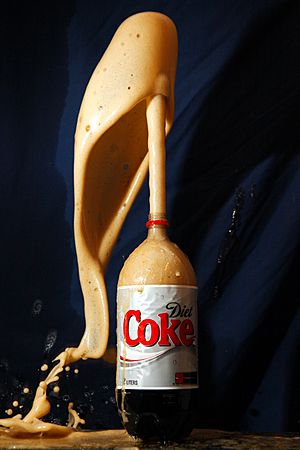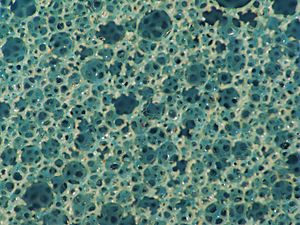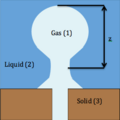Foam facts for kids
A foam is a cool substance made when tiny pockets of gas get trapped inside a liquid or a solid. Think about the bubbly top on a glass of soda or a bath sponge – those are both foams! In most foams, there's a lot of gas, and it's separated by very thin layers of the liquid or solid material.
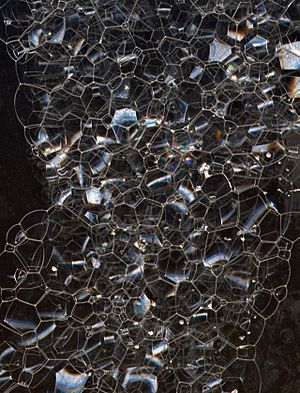
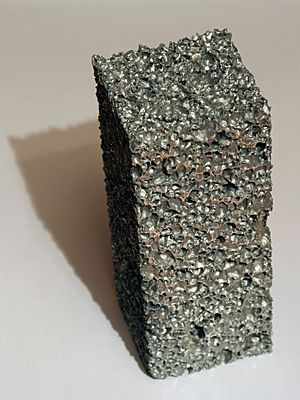
Solid foams can be either closed-cell or open-cell.
- In a closed-cell foam, the gas pockets are completely sealed off from each other by the solid material. Imagine a camping mat – it doesn't soak up water because the gas bubbles inside are trapped and sealed.
- In an open-cell foam, the gas pockets are all connected. A bath sponge is a great example: water can easily flow right through it because the air pockets are linked together.
Foams are a type of mixture where one substance (gas) is spread out in another (liquid or solid). The gas usually forms bubbles of different sizes. When the bubbles are very tiny, foam can be considered a type of colloid, which is a special kind of mixture.
The word "foam" can also describe things that look like foam, even if they're not made of gas and liquid/solid. Examples include quantum foam (a concept in physics), polyurethane foam (like foam rubber), or polystyrene (used in packaging).
Contents
How Foam is Structured
Foam is often a system with many different sizes, from tiny to large.
Bubbles and Their Shapes
One important part of foam is the bubbles themselves. In most materials, foam bubbles are not perfectly organized and come in many different sizes. When scientists study ideal foams, they look at how bubbles arrange themselves, often trying to find the best ways to fit them together, like in a honeycomb.
Scientists have even found a special shape called the Weaire–Phelan structure, which is thought to be the most efficient way for bubbles to pack together in a perfectly ordered foam. Also, Plateau's laws describe how the thin films of liquid in soap foams meet and form specific angles.
Thin Films and Borders
Below the size of the bubbles, there are the very thin films that separate the gas pockets. These films connect to form a network called lamellae. In an ideal foam, these films meet in groups of three, spreading out at 120-degree angles from their connection points. These connection points are known as Plateau borders.
Even smaller than the films is the surface where the liquid meets the air. This surface is often kept stable by special molecules called surfactants (like those in soap) or tiny particles.
Images for kids
-
Close-up of sea foam made from decomposing plankton on a tide pool
See also
 In Spanish: Espuma para niños
In Spanish: Espuma para niños


